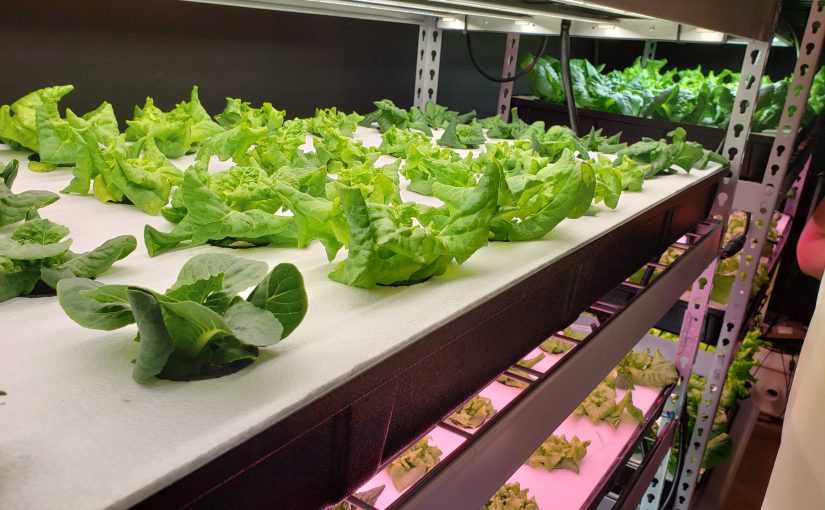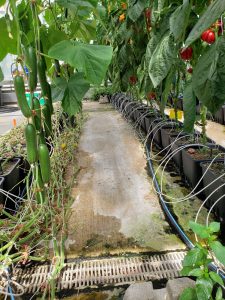Gardeners that read this blog understand that minerals are absorbed mostly by plant roots as ions, and are essential for plant growth and development. Some minerals are required in parts per hundred, and are macro-nutrients while others are only required in parts per million or parts per billion, and are considered micronutrients. As long as enough of the 16 most essential minerals are available, plants grow and reproduce in a healthful way. When not enough of one of the essential elements are available, a deficiency occurs, and plants
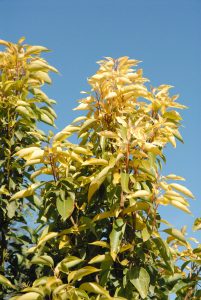
may present deficiency symptoms. Mineral nutrient deficiency symptoms are considered abiotic disorders. There are, however, cases where excess or deficiency of elements can be predisposing to disease caused by pathogens. Most some mineral elements do have a role in the development of disease caused by some pathogens but this is largely demonstrated in agriculture and often most home gardens do not suffer nutrient caused plant diseases.
Diseases can be either biotic with a living pathogen driving the disease or abiotic where a physiological condition is caused by the environment and host interactions. Mineral nutrients also are often implicated in abiotic disease.
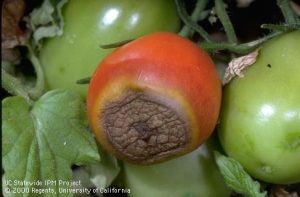
Perhaps the most famous one is blossom end rot of tomato. This disorder is seen by gardeners around the country and is widely attributed to calcium deficiency. Expanding fruit are a tremendous “sink” for nutrients like calcium and it was thought that if not enough calcium was available in soil the disorder would occur. It is accepted that localized Ca deficiency (in fruit) may play a role in the initiation of blossom end rot, but there are many other factors that lead to the full blown condition, some of which are not fully understood. The fact that blossom end rot (BER) occurs in calcic soils in California underpins the complexity of this disorder. In many cases, simply adding calcium to soils does not correct the problem. Research in California suggest that the plant hormone abscisic acid (ABA) regulates water flow, the development of water conducting tissues, and calcium uptake in tomato. Researchers found that ABA treated tomatoes were cured of blossom end rot. For gardeners, making sure plants are fertilized, and avoiding varieties susceptible to BER is the best course of action.
Soil-borne pathogens are perhaps most affected by minerals dissolved in soil solution. Minerals can act in specific ways (specific ion effects) or as total ion effects (osmotic strength or concentration) having direct impact on pathogenic propagules or on the host itself. In a biological disease relationship there are several possibilities:
• Specific ions harm or favor the pathogen.
• Specific ions harm or support the host.
• Ionic strength changes the root environment making the host weak and susceptible.
• Ions change the pH of the soil solution making it more or less fit for a pathogen or the host.
• Ions change the soil physical environment making it more or less fit for a pathogen or the host.
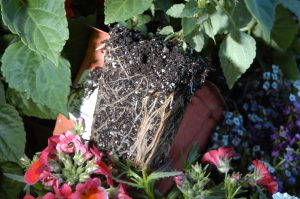
While it is often espoused that the well “fed” or fertilized plant is resistant to disease, it is rarely borne out in published research on ornamental plants. Keeping a good nutritional level in nursery stock will not necessarily protect plants from many of the virulent pathogens that are capable of causing disease. Excess fertilization may lead to luxury consumption by the fertilized plant and can produce succulent growth that will exacerbate of such diseases as powdery mildew. It is well known that seedling diseases caused (damping off) are more severe with increased medium salinity and it was later discovered that increased soil salinity also increases susceptibility of ornamental plants to Phytophthora root rot diseases. Phytophthora is the most common pathogen associated with rotted roots in most gardens.
Plant mineral nutrition supports plant health in two basic ways (1) formation of mechanical barriers (cell wall strengthening) and (2) synthesis of defense compounds that protect against pathogens. The role of specific elements and their compounds is complicated and unique to each disease/host system. Certainly deficiencies of molecules such as calcium and potassium can interrupt either defense mechanism and if nutrients are supplied enough to prevent deficiencies there is little role of nutrients in preventing disease.
Root rot is a disease of thousands of ornamental plants and a serious problem in many gardens. Root rots caused by Phytophthora spp. occur in a range of nutritional and pH ranges. Nitrogen has been shown to lessen root rots and this is likely due to conversion of nitrogen into ammonia gas in soil which acts as a fumigant. Many studies found no relationship of nitrogen source to root rot disease development. Calcium increases disease resistance to root rot in avocado and other plants. While it is understood that calcium has direct effects on plant membranes, root cell membrane leakage, cell wall thickness, and many other host factors, there are also direct effects on the pathogen in soil. Calcium ions reduce the production of disease spores and disrupt their ability to swim and find susceptible roots. When soils and soil less media are low in soluble calcium, when calcium is easily precipitated out of solution, or when the pH is high and limestone minerals decrease the availability of calcium, root rots will be able to infect. Increases of sodium ions in soils and soil less media can also increase Phytophthora caused diseases.
Some non-essential elements have become popular as disease suppressants. Research has shown Silicon increases resistance of plants to powdery mildew, root rots and to stress in general. Silicon is implicated in strengthening cell walls as well as in defense protein production in plants. But not all plants are capable of utilizing silicon, so its role in plant defense is limited to those species (mostly grasses) capable of metabolizing it. Silicon has been erroneously recommended for widespread disease prevention. Its actual utility is likely very narrow. Much more study is necessary to understand silicon’s role with ornamental plant-pathogen systems. Gardeners will find little use for silicon as a disease prevention too.
Plants extract minerals from container media and garden soils—the process is complicated; it is mediated by the substrate/soil, water chemistry, temperature and the applied minerals (fertilizers) as well as by plants. Gardeners should apply fertilizers that can supply a constant low level nutrient charge or rely on nutrients provided in mulches. Fertilizing decisions are best guided by having a low cost soil analysis by a University lab. Supplying extra soluble calcium may be helpful in managing root rots, especially where heavy rainfall is normal and soils may be highly leached. Preventing salt build up (by leaching irrigation) in high salinity soils (low rainfall places) and that can occur when media dries out, will also help plants avoid infection by root rot organisms. It is good to remember that fertilizers never cure diseases, but there may be a role in preventing disease when plants are nutrient deficient.
References
Baker K.F. 1957. The UC System Producing Healthy Container-Grown Plants. University of California Division of Agricultural Sciences Agricultural Experiment Station Publication #23.
Cherif M., Asselin A., Belanger R.R. 1994. Defense responses induced by soluble silicon in cucumber roots infected by Pythium spp. Phytopathology 84:236-242.
Datnoff, L.E., Elmer, W.H. and D. M. Huber eds. 2007. Mineral nutrition and plant disease. APS Press The American Phytopathological Society, St. Paul, MN. 278pp.
Downer A.J., Hodel D.R., Matthews D.M., Pittenger D.R. 2013. Effect of fertilizer nitrogen source on susceptibility of five species of field grown palms to Fusarium oxysporum f. sp. canariensis. Palms 57: 89-92.
Duvenhage J.A., Kotze J.M. 1991. The influence of calcium on saprophytic growth and pathogenicity of Phytopthora cinnamomi and on resistance of avocado to root rot. South African Avocado Growers Yearbook 14:13-14.
Faufeux F., Remus-Borei W., Menzies J.G., Belanger R.R. 2006. Silicon and plant disease resistance against pathogenic fungi. FEMS Microbiology Letters 249:1-6.
Kauss H., Seehaus K., Franke R., Gilbert S., Dietrich R.A., Kroger N.. 2003. Silica deposition by a strongly cationic proline-rich protein from systemically resistant cucumber plants. Plant J. 33:87-95.
Lee B.S., Zentmeyer GA. 1982. Influence of calcium nitrate and ammonium sulfate on Phytophthora root rot of Persea indica. Phytopathology 72:1558-1564.
Ma, J.F. 2011. Role of silicon in enhancing the resistance of plants to biotic and abiotic stresses. Soil Science and Plant Nutrition 50:11-18.
Macdonald J.D., Swiecki T.J., Blaker N.S., Shapiro J.D. 1984. Effects of salinity stress on the development of Phytophthora root rots. Cal Ag 38:23-24.
Messenger B.J., Menge J.A., Pond E. 2000. Effects of gypsum on zoospores and sporangia of Phytopthora cinnamomi. Plant Dis 84:617-621.
Powell C.W., Lindquist R.K. 1997. Ball Pest and Disease Manual (2nd ed). Ball Publishing Batavia Publishing. 426 pp.
Span T.M., Schumann A.W. 2010. Mineral nutrition contributes to plant disease and pest resistance. University of Florida Publication #HS1181. http://edis.ifas.ufl.edu.
Tonetto de Freitas, S., K.A. Shackel and E. J. Mitcham. 2011. Abscisic acid triggers whole-plant and fruit specific mechanisms to increase fruit calcium uptake and prevent blossom end rot development in tomato fruit. J. of Experimental Botany 62:2645-2656.
Daylor, M.D. and S. J. Locassio. 2004. Blossom-end rot: A calcium deficiency. J. of plant Nutrition 27: 123-139.
Zentmeyer G.A. 1963. Biological control of Phytophthora root rot of avocado with alfalfa meal. Phytopathology 53:1383-1387.
